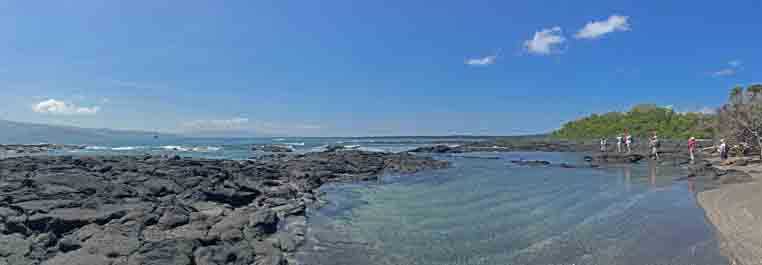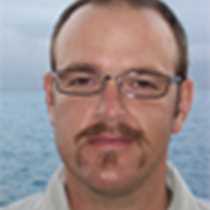As our Galapagos exploration continues, we are discovering a new world as we navigate towards Fernandina, the youngest island in the archipelago. A calm sea is before us as we search for signs of life in this deep sea. A cool mist accumulates over the water as we start to land at Fernandina Island, the “baby” of the island chain. The last eruption occurred here just a little over four years ago, and we note that the young lava flows from the outer flanks to the ocean.
As we approach the landing site, an occasional Pacific green sea turtle pops its head up for a breath of air. The pa hoe-hoe lava underfoot reveals forms that have been frozen in time as it cooled. Upon closer observation, we find hundreds of marine iguanas trying to warm themselves on the lava flows, some returning from the ocean where they have been foraging on algae. This environment reminds us of how the young earth must have looked, as life was first struggling to gain a foothold. There are desiccated marine iguanas that have died from the strong El Niño phenomenon that has affected the islands. A young Galapagos hawk attentively scans the surrounding point, looking for potential prey. Small lava lizards flit about as they nourish themselves on the black flies. As we reach Espinosa Point, we find Galapagos flightless cormorants practicing their aquatic courtship dance. A single penguin comes out of the water after feeding to preen its feathers. Some of us are surprised that life continues in such a desolate, yet beautiful environment.
Navigation into the afternoon brings us to the northern tip of Isabela Island, with its drastically formed environment. Punta Vicente Roca and Ecuador Volcano have a history of destruction and formation, as over half of Ecuador Volcano disappeared into the ocean in a past collapse, and Punta Vicente Roca formed as a result of the continuous volcanism. The conditions are calm as we enter the cold water, which is chilled due to the Cromwell upwelling current that comes from the West. Pacific green sea turtles rest on the sandy bottom and casually swim past us. A flightless cormorant swims by as it returns to its coastal nesting area, and brown noddies hover overhead searching for small fish. It is truly surprising the difference from one island to the next, not only in diversity of wildlife but in geological formations. We spot Galapagos fur seals along the coast and penguins actively feeding in the water as we return to our floating home and navigate towards the equatorial line. The views are impressive, we can observe the inside of the massive caldera that once was a large shield volcano. The sun continues upon its path and the light dips below the horizon, as we continue this exploration into the unknown.







